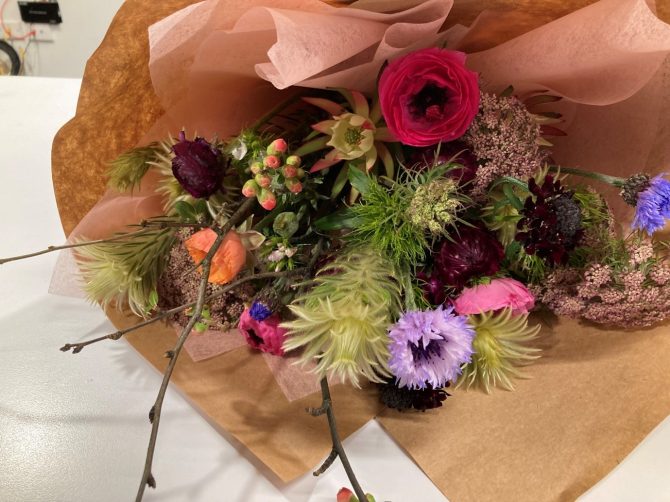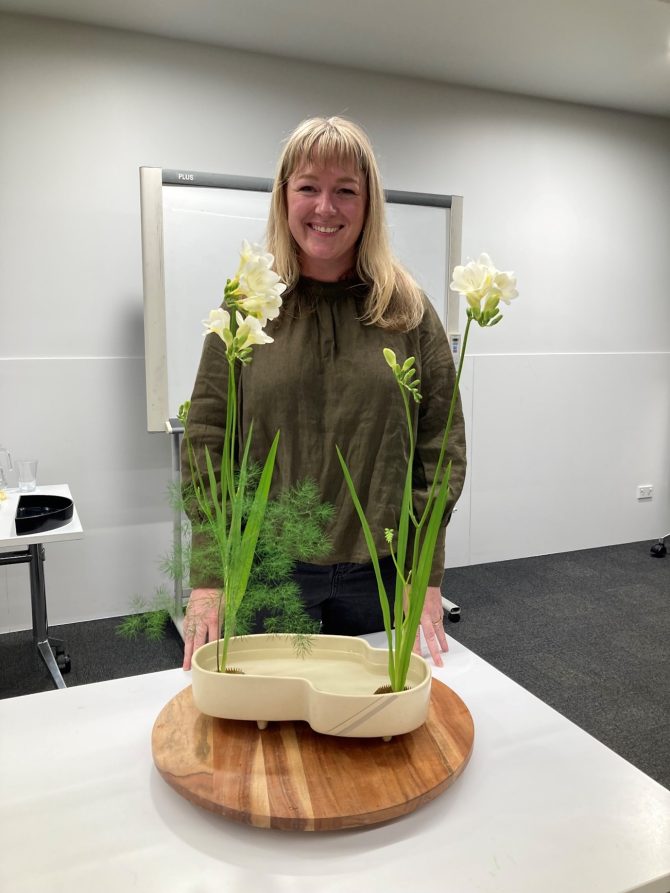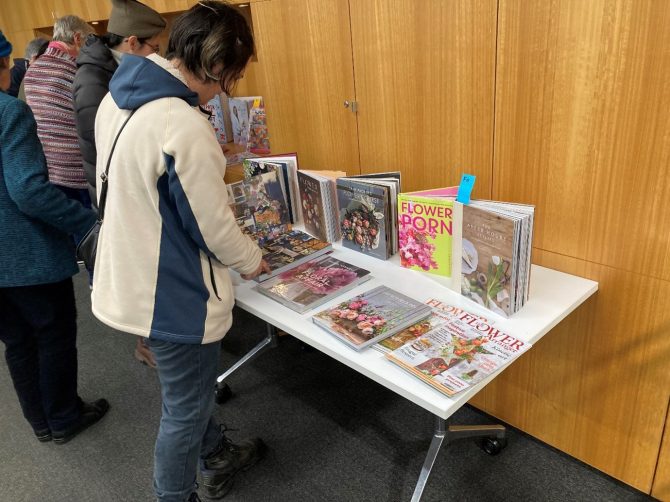Sally reports back from the last Craft Snippets event at Upper Riccarton Library with special guest, Claire Maetzig, farmer and florist with Moon River Flower Farm.
The next Craft Snippets event is at Upper Riccarton Library on Wednesday 27 September will feature Carmin Beck of Sundune Fibres.
It was lovely to see so many come along on the evening of 26 July to hear Claire Maetzig. A love of flowers and gardening is what started Claire off on her journey to her business Moon River Flower Farm.
Starting with flowers from her own garden
Claire didn’t care about gardening until she had her own home and was spending time walking around the neighbourhood with her baby looking at people’s gardens. With a change of lifestyle from the fast pace of career to home life, Claire saw things differently and loved being outside. Claire loved having flowers in the house, how fresh and alive they make a room feel. Unfortunately buying flowers was and is expensive, so Claire decided to grow her own instead. Luckily their first home already had raised beds and good soil.
With a move to a bigger house in Selwyn Street, the garden was more challenging and with more grass. Claire had to create the borders from scratch by digging up the lawn and adding gypsum to loosen up the clay. Claire found how difficult manual gardening could be, but also found that she was quickly running out of space.
Red zone foraging and ikebana
Claire was trying different ways of bringing flowers into the house, but realised you need a lot of flowers to make a bouquet, so wondered what other styles of arrangements she could try. Having lived in Japan, Claire knew about Japanese flower arranging Ikebana so googled it and found a Christchurch Club, Ikebana Christchurch NZ – Sogetsu.
Ikebana introduced Claire to the joys of foraging especially around the Christchurch red zone. Here hundreds of people’s gardens have been left to grow wild. You don’t find annuals but what you will find are interesting, like twisted branches from shrubs, perfect for ikebana. Claire showed photos of some of her ikebana arrangements using foraged plants.
Claire said her eyes were opened by ikebana and foraging in the red zone. She would spot something yellow 100 metres away and want to find out what it was. Over the years, Claire has become an expert of where certain plants are in the red zone, for example types of pine, hydrangeas and Gingko trees.
More space needed - expanding into the red zone
Claire found ikebana to really be about the flowers, not the gardening, and realised she needed even more space. Simultaneously, friends and family were asking Claire to make bouquets and arrangements. With this momentum, Claire had decisions to make, where was she going with this business? And what was it about the business she liked doing? Buying flowers didn’t give Claire the same satisfaction as growing them herself. A florist often buys flowers unseen off a list and can’t be sure of the quality. Claire felt inspired to grow her own, but the idea of expansion was scary.
Claire was familiar with the red zone from her foraging and knew the land well, what was boggy, what wasn’t, what had good aspect, what didn’t. Claire applied to the Christchurch City Council to be able to lease half an acre of land in the red zone. After months of meetings and paperwork, Claire started to set up Moon River Flower Farm at 45-49 Trent Road. How did Claire come up with her business name? Claire said it was because the site is close to a bend in the river, the Ikebana school Claire is associated with has the moon crescent as their symbol, and Claire loves the song ‘Moon River’ and the fantasy idea behind it. Another reason for being in the red zone was that part of her business plan was to do pick your own flowers and Claire wanted somewhere that was easily accessible to people.
Set up began in Autumn 2021 to turn half dead grass and weeds into viable land to grow. Claire wanted a no dig strategy for two reasons. Firstly, Claire loved the idea of not physically digging and secondly, she didn’t have a tractor. Four dump trucks later Claire had a thick layer of compost and set about having a working bee with friends and family to help shovel the compost. Claire then covered everything in black plastic to keep the weeds at bay while she planted and set up the irrigation. Claire sources her seeds from Kings Seeds and Egmont Seeds.
The first flowers were ready in October 2021 and were tulips. This year Claire expects to have 3000 tulips. Other flowers Claire grows include cosmos, marigolds, dahlias, cornflowers, queen Anne’s lace, straw flowers, and ornamental carrot. Claire loves flowers that you wouldn’t traditionally see in a bouquet.
After Claire had put in the money and mahi, the pressure was on to sell the flowers. Claire spent time figuring out what she liked doing including bouquets, weddings, workshops and pick your own.
Claire particularly likes the pick your own and the fun of having people at the farm walking around enjoying the flowers. Claire likes to keep the pick your own simple. People are given a pair of scissors and a container. Claire looks at the weather for the week and picks the date. People buy a ticket online. Picking is only over the summer months.
Sustainability
Claire also works with a local textile artist, Seonaid Burnie of The Clothworks, providing flowers and plants for them to make natural dyes. The flowers used, such as marigolds, are past saleability but still useful as a product to make dye.
Claire doesn’t use any sprays and likes to work sustainably. Claire looks for flowers that are willing to grow in our environment, a flower that is happy to be grown outside in an open field in Christchurch, “if it doesn’t want to grow, don’t grow it”. Good advice for any gardener. Compost is horse poo and green manure crops that Claire buys in bulk.
Claire says she is never going to be a millionaire but is having a good time doing what she loves. The biggest challenge is time - there is never enough. Claire has lots of ideas but doesn’t have time to do them all. It is a delicate balance between keeping the business the way Claire wants, during school hours, days off for school events, being in charge. To keep the balance Claire has to say no to some stuff, and that is ok.
Ikebana demonstration
Claire gave an ikebana demonstration with two beautiful freesia flowers. You need minimal material for ikebana and Claire said when something looks as beautiful as these two freesia stems, why put them into a bunch where they would get bruised and lost. Claire said you need to think about the vessel or vase and how it speaks to the plants you are using. There are two types of ikebana vases, moribana and nagere, and you use a kenzan / flower pin frog to fix flowers into the shallow dish.
There is a lot of experimentation and taking time to look at the flowers and see how ‘they want to be’. Also think about where the arrangement is going to go when you are finished. A great tip from Claire was to cut the stem of the flower under water to help with longevity. Avoid the flowers crossing each other, there should be space between the objects so that a butterfly might fly through them. Simple is so elegant and beautiful. Take time to appreciate each element.
You can find out more about Claire and Moon River Farm on this news story, Seven Sharp story about Moon River Farm.
Latest craft titles
Here is a book list of the items shared:
What's on
Claire mentioned workshops on how to make flower arrangements, run by the Canterbury Horticultural Society
Sally did a roundup of crafty events on around Christchurch:
- The Great Stash Swap at Upper Riccarton Library, Sunday 27 August, 11am to 2pm
- Hornby Indoor Market
- Stitch-O-Mat Winter Sale, Saturday 26 August, 11am to 2pm
- Get Flocked – exciting new yarn shop in town.
Wendy talked about the local Riccarton Horticultural Society, their upcoming Spring show and monthly speaker.







Add a comment to: Craft snippets: Flower farming and arranging with Claire Maetzig